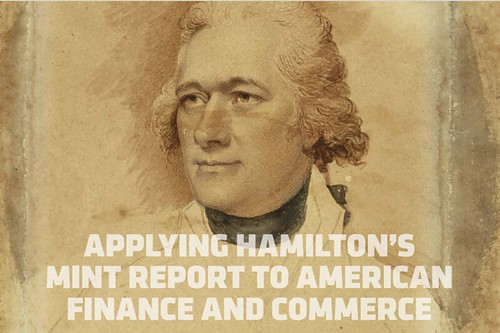
PREV ARTICLE
NEXT ARTICLE
FULL ISSUE
PREV FULL ISSUE
V25 2022 INDEX E-SYLUM ARCHIVE APPLYING HAMILTON'S 1791 MINT REPORTLen Augsburger passed along an article by Eric Brothers in the Fall 2022 Financial History Magazine from the Museum of American Finance titled "Applying Hamilton's Mint Report to American Finance and Commerce." Thanks. Here's an excerpt. -Editor
Alexander Hamilton's 1791
A main theme of Hamilton's Report was
that the national unit of account would be
the dollar. Through images and mottos, as
well as everyday use, the dollar (both in
gold and silver) would promote the bimetallic standard Hamilton desired. It would
also provide a tangible embodiment of
being an American and would help citizens
identify with the United States as a nation,
not just with their individual states. The
idea was for the new American coinage
to push out of circulation the ubiquitous
Spanish-American eight reales (also called
It was important to Hamilton to mint
both gold and silver one-dollar coins. In
Alexander Hamilton on Finance, Credit,
and Debt, Richard Sylla and David Cowen
write, Among the themes in Hamilton's Report was ending the circulation of foreign coins within a three-year period. He provided some latitude for the Spanish dollar to remain in circulation for a longer time. The intention was to have all foreign coins brought to the Mint to be melted into bullion and used to strike the new national coinage, with iconic imagery and mottos. This was part of Hamilton's concept of employing American coinage to create connections between the American people and the nascent United States, although the coins were intended for international trade and not solely for domestic consumption. However, this important proposal was not included in the Coinage Act of 1792, and foreign coins were allowed in commerce as legal tender until the Coinage Act of 1857. Thus, an important and voluminous source of bullion was not available to produce the new national coinage. During the 1790s, silver mining production in the United States was virtually nonexistent. Therefore, Congress' decision to allow foreign coins to continue circulating unabated severely hampered the Mint's ability to produce a large quantity of American coinage for everyday commerce. Ah, what might have been! The article discusses the fineness of silver coinage and U.S. coinage undervaluation, which led to many being shipped overseas rather than entering commerce. -Editor The surviving coins today—many of which are great rarities—were the subject of hoarding and possible storage in banks. This begs the question of why, over the course of 40 years, did Congress not once modify the silver to gold ratio? If gold merchants were regularly bringing gold bullion to the Mint to be converted into coins for the sole purpose of export, why did Mint officials not petition Congress to amend the law and charge seigniorage? Hamilton left the US Treasury in 1795 and died in 1804, and no other financial minds stepped in to successfully confront these challenges. Congress and successive Mint directors discussed and complained about these problems for 40 years, yet nothing was done to fix them.
To read the complete issue on the Newman Numismatic Portal, see:
Wayne Homren, Editor The Numismatic Bibliomania Society is a non-profit organization promoting numismatic literature. See our web site at coinbooks.org. To submit items for publication in The E-Sylum, write to the Editor at this address: whomren@gmail.com To subscribe go to: https://my.binhost.com/lists/listinfo/esylum All Rights Reserved. NBS Home Page Contact the NBS webmaster 
|


